|
The impact of advance management accounting
techniques on performance: The case
of Malaysia

Abdullah Mohamed Ahmed Ayedh (1)
Chaabane Oussama Houssem Eddine (2)
(1) Universiti Sains Islam Malaysia,
Department of Accounting
(2) International Islamic University
Malaysia, Department of Accounting
Correspondence:
Chaabane Oussama Houssem Eddine
International Islamic University Malaysia,
Department of Accounting
Malaysia
Email:
Oussama.ch33@yahoo.fr

Abstract
Purpose:
The paper aims to examine the adoption
of several Advance Management Accounting
(AMA) techniques (i.e. total quality
management (TQM), activity based costing
(ABC), the ISO 9000 certificate, the
balanced scorecard (BSC), strategic
management (SMA), value based management
(VBM), and benchmarking) by the listed
companies on Bursa Malaysia (i.e.
the Malaysian stock exchange). In
addition, the paper examines the impact
of the adopted AMA techniques on a
company's overall performance.
Design/methodology/approach:
The paper used a questionnaire survey
method to gather the required data.
The questionnaires were distributed
to senior managers of selected listed
companies. The paper used descriptive
statistic, correlation and regression
techniques to analyze the data.
Findings: The paper found that
benchmarking, balanced scorecard,
and total quality management are among
the AMA techniques widely adopted
by Malaysian listed companies. In
addition, the paper found that the
adoption of AMA techniques significantly
influenced the companies' overall
performance. More specifically, the
paper found that the adoption of balanced
scorecard significantly influenced
the companies' profitability, customer
satisfaction, market position, and
sales growth for existing services
and products.
Research limitations/implications:
This paper focused solely on seven
well-known AMA techniques. In addition,
the paper only used data collected
by a questionnaire survey.
Practical implications - The findings
of the paper provide empirical evidence
on the current adoption of AMA techniques
by Malaysian listed companies. These
findings could be considered important
and useful for advancement of companies
adopting AMA techniques to improve
their performance. On the other hand,
the findings can potentially encourage
companies yet to adopt AMA techniques
to do so in order to maximize their
potential in a highly competitive
and global corporate environment.
Originality/value: This paper
contributes to the management accounting
literature in Malaysia by identifying
the advantages of adopting the AMA
techniques, especially balanced scorecard
and benchmarking, in the Malaysian
context.
Key words: Management accounting
technique, Performance, Listed companies,
Malaysia.

1. Introduction
As a remedy to the weakness of
traditional performance measurement
models, a number of AMA systems or
techniques were introduced in the
last fifty years (Kaplan and Norton,
1992). Examples of such techniques
are total quality management (TQM),
activity based costing (ABC), ISO
9000 certificate, balanced scorecard
(BSC), strategic management accounting
(SMA), value based management (VBM),
and benchmarking (BNC). The AMA techniques
can be defined as a set of theories,
standards, actions and analytic frameworks
that aim to control and measure an
organization's performance (Rigby,
2001).
According to the International Monetary
Fund (IMF) report (2006), the Malaysian
economy is seeing continued high growth.
The Malaysian GDP has continuously
increased year by year (IMF reports,
2006; 2007). The fast growth of the
Malaysian economy along with globalization
have encouraged Malaysian companies
to adopt AMA techniques such as TQM
and BSC (Bontis et al., 2000; Naser
et al., 2004; Samat et al., 2006;
Wei and Nair, 2006) as a means to
respond to global market competition.
AMA techniques are a selection of
analytical tools to optimize the performance
of a firm (i.e. TQM, ABC, ISO 9000
certificate, BSC, SMA, VBM, and benchmarking).
Each technique provides nuanced performance
information. The BSC was defined by
Kaplan et al. (2004) as a strategic
management technique that translates
an organization's strategy into clear
objectives, measures, targets and
initiatives organized by four perspectives,
while, TQM is defined as a set of
management concepts and tools that
aim to involve managers, employees
and workers to yield continuous performance
improvement (Hoque, 2004). ABC allocates
overhead costs based on specific activities
to generate certain products or render
services (Kaplan et al., 2004). The
ISO 9000 certificate was established
in 1987 and is defined as an international
set of five related standards for
qualification of global quality assurance
and quality control standards (Yahya
and Goh, 2001; Naser et al., 2004).
The SMA is defined as a general advanced
approach to accounting for strategic
positioning (Cinquini and Tenucci,
2006). The VBM focuses on better decision-making
at all levels in an organization.
Lastly, the BNC is a process of studying
and comparing successful practices
and selecting the best for improving
an organization's performance (Letts
et al., 1999).
The paper aims to examine the adoption
of AMA techniques by Malaysian listed
companies and the impact those techniques
have on company performance. The findings
provide information from which Malaysian
listed companies can further explore,
understand and improve the role of
AMA techniques to improve their performance
in a highly competitive business environment.
The paper is organized as follows.
Section two briefly reviews the prior
literature on company performance
and adoption of AMA techniques. Section
three explains the research methodology.
Section four presents and discusses
the results and findings. Section
five concludes the paper.
2. Literature
review
There is a considerable body of literature
on issues concerning the adoption
of AMA techniques and its significance
to company performance. Generally,
companies tend to apply AMA techniques
to improve their performance (Chenhall
and Smith, 1998; Rigby, 2001; Hussain
et al., 2002; Abdel-Maksoud, 2004).
It has been argued that the AMA techniques
directly enhance performance measurement
practices (Koller, 1994; Chenhall
and Smith, 1998; Zairi, 1998; Letts
et al., 1999; Rigby, 2001; Hussain
et al., 2002; Abdel-Maksoud, 2004;
Cinquini and Tenucci, 2006). For example,
it has been found that companies that
adopt the BSC perform better than
those companies that do not (Davis
and Albright, 2004; Anand et al. 2005;
Neely, 2008). Furthermore, prior studies
found a positive relationship between
registering ISO certificates and a
company's performance (Yahya and Goh,
2001; Naser et al., 2004; Ann et al.
2006). In addition, companies adopting
the TQM often see improved performance
(Samat et al., 2006). The same was
found for benchmarking and ABC techniques
(Chenhall and Smith, 1998 and Rigby,
2001).
In USA, Davis and Albright (2003)
initiated a quasi-experimental study
to examine whether the bank branches
that implemented the BSC saw any improvement
in financial performance. They found
that branches that applied BSC performed
better than branches that did not.
Another study in the UK by Neely et
al. (2005) investigated the impact
of implementing the BSC by using a
quasi-experimental study. The result
indicated that there was a positive
improvement in sales, gross profit
and net profit, but when they compared
the sales and gross profit with a
sister organization which was using
the traditional profitability method
to measure the performance there was
no relationship. In Taiwan, Wang (2004)
examined the relationships between
a set of exchange ratios (financial
measures) and the BSC (integrated
financial and non-financial measures)
for a sample of 32 companies and acquisitions
of 14 financial holding companies.
The results also indicated that firms
practicing BSC are performing better
than firms without BSC. Anand et al.
(2005) investigated the current practices
of BSC (design and function) in Indian
organizations. They found that the
majority of the sample of Indian companies
that implemented the BSC had better
classification of cost reduction opportunities,
which leads to improvement in the
bottom line of company performance.
Samat et al. (2006) explored the practices
of TQM in two aspects, namely quality
service and market orientation based
on a questionnaire-survey. The results
indicated that employee empowerment,
information and communication, customer
focus, and continuous improvement
significantly influenced service quality,
whereas only the first two factors
(i.e. empowerment and customer focus)
had an important impact on market
orientation.
3. Research
methodology
3.1 Sample selection
This paper targeted a sample of senior
managers as respondents because they
are responsible for adopting and implementing
new accounting techniques or systems.
As such, they are ideally positioned
to provide the necessary data. This
paper focuses on Malaysian companies
listed on Bursa Malaysia (i.e. the
Malaysian stock exchange) because
they are big companies and have more
recourse to adopt the AMA techniques
compared to non-listed companies.
Although Bursa Malaysia classifies
the listed companies into sectors
(i.e. industries), the current paper
has used the cross-sectional research
method that selects companies regardless
of industry or sector. At the time
of the study, a total of 891 companies
were listed on the Bursa Malaysia
website. A random sampling method
was used to select the required companies,
which resulted in a sample of 234
companies.
3.2 Data collection
Data was collected through the questionnaire
survey method. The questionnaire was
developed from the prior research
of Kald and Nilsson (2000), Speckbacher
et al. (2003), Evans (2004) and Anand
et al. (2005). Some modifications
were made to simplify certain terminologies
used in the questionnaire. In addition,
the differences of location and environment
of the research were considered and
controlled accordingly. The questionnaire
was comprised of three sections. The
first section obtains the performance
measurement practices in organizations.
The second section obtains the managers'
perceptions of the performance of
the company over the past five years.
The third and final section obtains
the demographic information of the
respondents.
A pilot test was conducted before
distributing the actual questionnaires
in order to enhance the reliability
of the survey. The pilot questionnaires
were disturbed to a group of academics
and five listed companies. The questionnaire
was then modified based on the feedback
and suggestions received.
Prior to the regression analysis,
factor analysis was conducted to summarize
or reduce the data to obtain the most
influential group of variables regarding
performance. The factor analysis resulted
in the following three groups. The
first group is AMA1, which includes
BNC, VBM, and ISO. The second group
is AMA2, which consists of ABC, SMA.
The third group is AMA3, which represents
BSC. In addition, six performance
components (i.e. profitability, customer
satisfaction, market share, market
position, growth of existing product
and service and product innovation)
are factored under overall performance
(OP). Table 1 shows the measurements
and definitions of the variables used
in the paper.
Table 1: Variables measurement
and definition
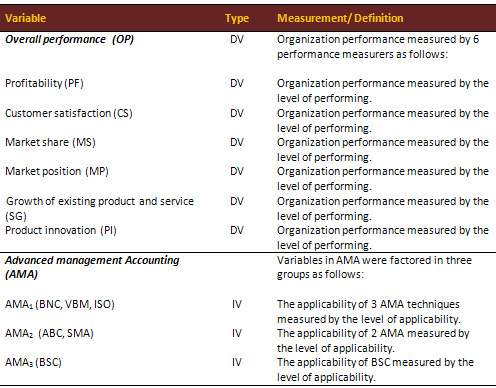
For satisfactory results, the paper
applied a stepwise regression model
to examine the influence of AMAs (i.e.
independent variable) on the company's
performance (i.e. dependent variable).
The first stage in the stepwise regression
assesses the impact of the adoption
of AMAs on overall performance. The
second stage focuses on the impact
of the adoption of AMAs on each component
of organizational performance (profitability
(PF); customer satisfaction (CS);
market share (MS); market position
(MP); growth of existing product and
services (SG); product innovation
(PI). The equations of the regression
models are specified in Table 2 as
follows:
Table 2: Regression equations
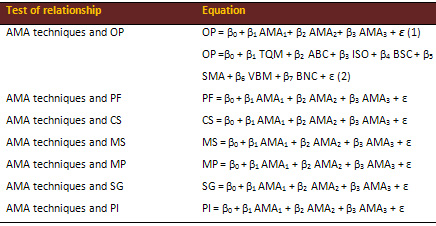
4. Findings
and discussion
4.1 Survey and respondents' background
The questionnaire was divided into
two stages. In the first stage, the
questionnaires were sent to all 234
companies through mail (117 companies),
e-mail (84 companies) and fax (33
companies) to avoid any bias in the
distribution process. In the second
stage, two weeks after finishing the
first stage, all companies in the
sample population received a call
from the researcher or his assistants
to confirm receiving the mail, e-mail
and fax requesting their participation.
A total of 65 questionnaires were
received of which 50 questionnaires
were useable. A response rate of 21.4
percent was obtained which can be
considered an acceptable rate for
that sample size (Sekaran, 2003).
In regards to the respondents' background,
the majority of respondents are upper
or middle management with more than
2 years' experience. Such conditions
provide logical assurance of the validity
of the responses.
4.2 Reliability tests
Reliability and validity tests were
conducted based on the normality and
multi-collinearity of variables (Sekaran,
2003). The results indicate that the
variables are reliable. In addition,
a non-response bias test for the late
response was conducted by comparing
the mean of the first and last ten
on the data. The results showed that
there was no such problem.
4.3 Descriptive statistics
Table III, panel A shows the descriptive
statistics of the implementation of
AMA techniques. Based on the mean,
the most popular AMA technique is
benchmarking. This finding is similar
to the findings of studies in Europe
and US (e.g. Hussain et al., 2002;
Abdel-Maksoud, 2004; Evans, 2004).
This is followed by the balanced scorecard,
total quality management, ISO 9000
certificate, value based management,
activity based costing and strategic
management accounting techniques respectively.
Comparing these findings with Sulaiman
et al.'s (2004) revealed that only
28 percent of companies used ABC.
In addition, Malaysian companies gradually
adopted the BSC. This result indicates
that Malaysian companies are increasingly
implementing the AMA techniques, which,
as suggested by Samat et al. (2006),
is partly the result of the steady
growth of the Malaysia economy and
efforts to attract international companies
to Malaysia that implement AMA models.
Panel B of Table 3 presents how managers
perceived company performance for
the past five years in terms of profitability,
customer satisfaction, market share,
market position and sales growth of
existing services and products. The
table shows that managers perceived
customer satisfaction and profitability
respectively as the most important
indicators of company performance.
However, managers did not perceive
the market share as an important indicator
of company performance.
Table 3: Descriptive statistics
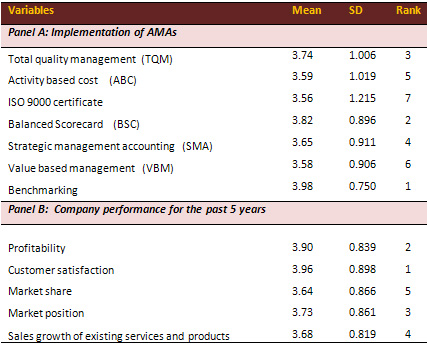
4.4 Regression analysis
As mentioned earlier, the main
objective of the regression is to
examine the impact of AMA techniques
on a company's performance. Prior
to running the regression analysis,
the paper performed normality and
multi-collinearity tests to ensure
the data is normally distributed and
to check the requirements of running
the regression analysis are met. The
results of these tests show that the
data was normally distributed and
there were no multi-collinearity problems.
4.4.1 Overall performance
Table 4 shows the results of the
first regression model that tests
the relationship between the applicability
of AMAs in the sampled companies and
the Overall Performance (OP).
The results show that the AMA1
and AMA2 are
significant. The results from Table
IV revealed that the AMA1
and AMA2 significantly
influence the OP with the exception
of BSC. This finding is consistent
with most prior studies (e.g. Yahya
and Goh, 2001; Ann et al. 2006) Since
only the first two groups of AMA were
significant, it would be interesting
to examine the impact of each AMA
technique, i.e. TQM, ABC, ISO, BSC,
SMA, VBM, and BNC, on OP.
Table 4: Regression analysis results
of overall performance

Table 5 shows that the BSC significantly
influences OP. The result suggests
that when each AMA works individually
to improve performance, BSC is the
most effective technique. This finding
is consistent with some prior studies
(e.g. Davis and Albright, 2004; Anand
et al. 2005; Neely, 2008).
Interestingly, BSC has no significant
impact on OP when it is regressed
with other AMA techniques. However,
when each AMA technique is regressed
with OP, only BSC and benchmarking
significantly influence the OP. In
addition, the study further tests
the impact of the adoption of AMA
techniques with each performance indicator
(i.e. PF, CS, MS, MP, SG, and PI).
The following section analyzes and
discusses these findings.
Table 5: Regression analysis results
of overall performance
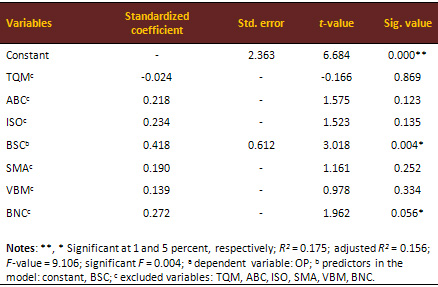
4.4.2 Profitability
As a dependent variable the PF has
been regressed with the AMA techniques.
The results are presented in Table
6. The results show that only AMA3
(i.e. BSC) has a significant impact
on PF (b=0.292,
p=0.010). This shows that the importance
of BSC in improving the organizational
performance, especially financial
indicators.
Table 6: Regression analysis results
of profitability a
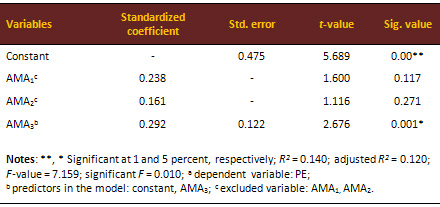
4.4.3 Customer
satisfaction
Table 7 reports the result of the
regression analysis that tests the
relationship between CS and AMA techniques.
The results reveal that only BSC influences
CS significantly (b
=0.315,
p=0.033), whereas other AMAs did not.
The possible reason for this could
be that customer perspective is one
of the BSC's indicators, and as such,
it seems that adopting BSC has a significant
impact on customer satisfaction.
Table 7: Results of regression
analysis of customer satisfactiona
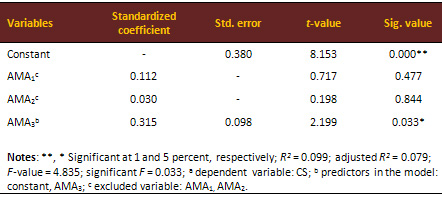
4.4.4 Market share
Table 8 presents
the results of the regression analysis
of the relationship between the MS
and the AMA techniques. The results
indicate that only AMA1
(BNC, VBM, ISO) influences MS significantly
(b =0.448,
p=0.002), whereas other AMAs did not.
The possible explanation of this result
is that AMA1 techniques are related
to the competitive perspective especially
BNC and ISO that are logically related
to the market share performance indicator.
Surprisingly, the results with respect
to AMA1 (BSC)
had no significant impact on MS although
it is logically related.
Table 8: Regression analysis results
of market shares
a
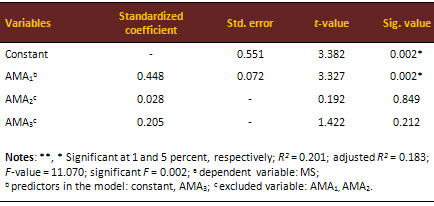
4.4.5 Market position
Table 9 shows the regression analysis
results of the relationship between
the MP and AMA techniques. The result
reveals that AMA3
(i.e. BSC) had a significant impact
on MP (b
=0.366, p=0.021), while there was
no significant impact when applying
other AMAs on MP. In other words,
it can be said that implementing the
BSC leads to an improved market position
of the organization.
Table 9: Regression analysis results
of market position a
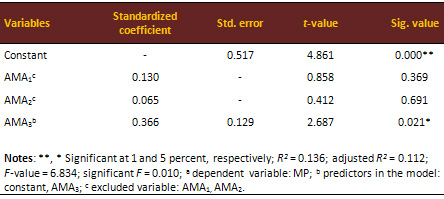
4.4.6 Sales growth of existing
services and products
Table 10 reports the result of the
regression analysis of the relationship
between SG and AMA techniques. The
results indicates that only AMA3
(i.e. BSC) significantly impacted
on SG (b
=0.376, p=0.010). In other
words, one advantage of the implementation
of BSC is the improvement of the sales
growth for existing services and products
of the company. A possible explanation
of this result is that BSC is financial
and non-financial measure of performance.
The non-financial measures such as
customer stratification might impact
the sales of the companies by taking
customers' feedback into consideration.
Table 10:
Regression analysis results of sales
growth a
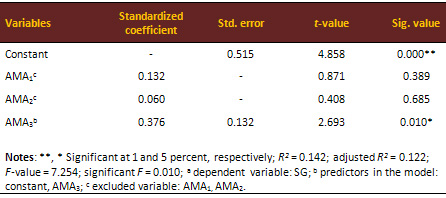
4.4.7 Product innovations
Table 11 shows the results of the
regression analysis on the relationship
between PI and AMA techniques. The
results show that AMA2
has a significant influence on PI
(b =0.398,
p=0.006). This result shows the importance
of ABC and SMA by ensuring that management
is provided with the necessary environment
for product innovation.
Table 11: Regression analysis results
of product innovations a
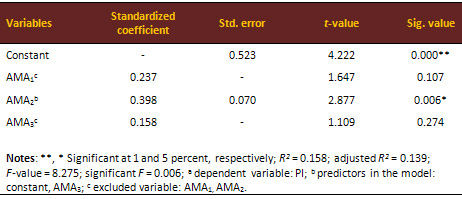
In order to simplify the result of
the regressions presented above, all
the regression results discussed are
presented into a diagram as illustrated
in Figures 1 and 2 below.
Figure 1: Regressions of overall
performance and AMAs
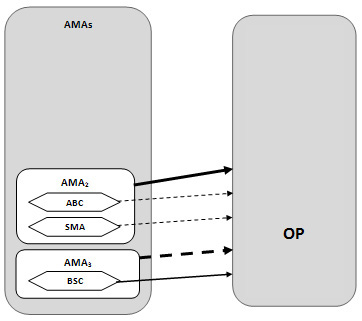
Figure 2: Regressions of specific performance
and AMAs
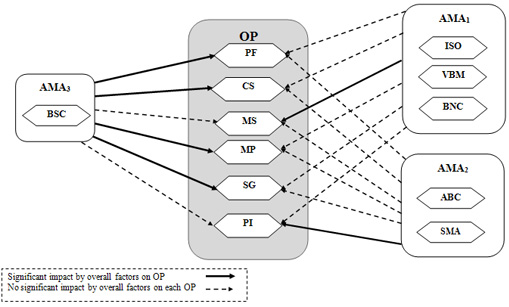
5. Conclusion
The main aim of this study is to explore
the relationship between the applicability
of AMA and performance. This study found
that applying AMA1 (ISO, VBM, and BNC)
and AMA2 (ABC and SMA) has significant
impact on the overall company's performance.
Examining company performance through
the collective application of all techniques
could generate stronger impact on company
performance than the BSC alone. In addition,
adopting balanced scorecard significantly
influenced company profitability, customer
satisfaction, market position, and sales
growth for existing services and products.
Despite certain limitations in this
study, namely that the study examined
only seven advanced managerial accounting
techniques, which are well-known in
literature, companies may nevertheless
initiate improvement programs that do
not fall into the specific well-known
packages, which may also affect the
design of the performance measurement
system. Second, this study found a significant
increase in the adoption of AMAs, which
had greater focus on nonfinancial performance
measures as compared to the previous
study by Sulaiman et al. (2004). However,
Ayedh and Muslim (2009) found that performance
measurement systems (PMSs) of many companies
mainly focus on financial performance.
These findings may indicate that Malaysian
companies are adopting AMAs for the
sake of mimicking. Therefore, to gain
greater understanding on this matter,
further research could be undertaken
using the case study approach under
the new institutional sociology perspective.
References
Abdel-Maksoud A. (2004), "Manufacturing
in the UK: Contemporary characteristics
and performance indicators",
Journal of Manufacturing Technology
Management, Vol. 15 No. 2, pp. 155-171.
Anand, J., Sahay, B., and Saha, S.
(2005), "Balanced Scorecard in
Indian Companies", Vikalpa, Vol.
30 No. 2, pp. 11-25.
Ann, G., Zailani, S., and Wahid,
N. (2006), "A study on the impact
of environmental management system
(EMS) certification towards firms'
performance in Malaysia", Management
of Environmental Quality: An International
Journal, Vol. 17 No. 1, pp. 73-93.
Ayedh, A., Muslim, M. (2009), "Performance
measurement practices in the Malaysian
companies: An exploratory study",
paper presented at the First International
Conference of Finance, Business &
Accounting, Kuala Lumpur.
Bontis, N., Keow, W.C.C. and Richardson,
S. (2000), "Intellectual capital
and business performance in Malaysian
industries", Journal of Intellectual
Capital, Vol. 1 No. 1, pp. 85-100.
Chenhall, R. and Smith, K., (1998),
"Adoption and benefits of management
accounting practices: an Australian
study", Management Accounting
Research, Vol. 9, pp. 1-19.
Cinquini, L. and Tenucci, A. (2006),
"Strategic Management Accounting:
Exploring distinctive features and
links with strategy", MPRA, paper
No. 212. Available at http:// mpra.ub.uni-muenchen.de/212/
(accessed 10 March 2009).
Davis, S. and Albright, T. (2004),
"An investigation of the effect
of Balanced Scorecard implementation
on financial performance", Management
Accounting Research, Vol. 15, pp.
135-153.
Evans, J. (2004), "An exploratory
study of performance measurement systems
and relationships with performance
results", Journal of Operations
Management, Vol. 22, pp. 219-232.
Hussain, M., Gunasekaran, A., and
Islam, M. (2002), "Implications
of non-financial performance measures
in Finnish banks", Managerial
Auditing Journal, Vol. 17 No. 8, pp.
452-463.
IMF International Mandatory Fond
report (2007). Retrieved May 9, 2007,
available at:
http://www.imf.org/external/pubs/ft/ar/2007/eng/index.htm
IMF International Mandatory Fond
report (2006). Retrieved May 9, 2007,
available at:
http://www.imf.org/external/pubs/ft/ar/2006/eng/index.htm
Hoque, Z. (2004) "A Contingency
Model of The Association Between Strategy,
Environmental Uncertainty and Performance
Measurement: Impact on Organizational
Performance." International Business
Review 13.
Kald, M. and Nilsson, F. (2000),
"Performance measurement at Nordic
companies", European Management
Journal, Vol. 18 No. 1, pp. 113-127.
Kaplan, R.S. and Norton, D.P. (1992),
"The balanced scorecard: Measures
that drive performance", Harvard
business review, Vol. 70 No. 1, pp.
71-9.
Koller, T. (1994), "What is
value-based management? An excerpt
from Valuation: Measuring and Managing
the Value of Companies", McKINSEY,
No. 3, quarterly second edition.
Letts, C., Ryan, W. and Grossman,
A. (1999), "Benchmarking: How
non-profits are adapting a business
planning tools for enhanced performance.
Available at http://www.tgci.com/magazine/Benchmarking.pdf
(accessed 21 March 2011).
Naser, K., Karbhari, Y., and Mokhtar,
M. (2004), "Impact of ISO 9000
registration on company performance:
Evidence from Malaysia", Managerial
auditing journal, Vol.19 No.4, pp.
509-516.
Neely, A. (2008), "Does the
Balanced Scorecard work: An empirical
investigation". Working paper
series, available at http://dspace.lib.cranfield.ac.uk/handle/1826/3932
(accessed 21 March 2011).
Rigby, D. (2001), "Management
Tools and Techniques: A survey",
California Management Review, Vol.
43 No. 2, pp. 139-160.
Samat, N., Ramayah T. and Saad N.
(2006), "TQM practices, services
quality, and market orientation: Some
empirical evidence from a developing
country". Management Research
News, Vol. 29 No. 11, pp. 713-728.
Speckbacher, G., Bischof, J., and
Pfeiffer, T. (2003), "A descriptive
analysis on the implementation of
Balanced Scorecards in German-speaking
countries", Management Accounting
Research, Vol. 14 No.4, pp. 361-387.
Sekaran, U. (2003), Research Methods
for Business a skill building approach,
John Wiley and Sons, Inc, Canada.
Sulaiman, M., Nik A., and Alwi, N.
(2004), "Management accounting
practices in selected Asian countries"
Managerial Auditing Journal, Vol.
19 No. 4, pp. 493-508.
Wang, W. (2004), "An evaluation
of the balanced scorecard in equity
valuation: The case of exchange ratio
in the M&As of Taiwan's financial
industry. Journal of intellectual
capital Vol. 6 No. 2, pp. 206-221.
Wei, K. and Nair, M. (2006), "
The effects of customer services management
on business performance in Malaysian
banking industry: an empirical analysia",
Asia Pacific Journal of Marketing
and Logistics, Vol. 18, No. 2, pp.
111-128.
Zairi, M. (1998), "Benchmarking
at shorts", Benchmarking for
Quality Management and Technology,
Vol. 5 No. 1, pp. 13-20.
Yahya, S. and Goh, W. (2001), "The
implementation of an ISO 9000 quality
system", International Journal
of Quality and Reliability Management,
Vol. 18, No. 9, pp. 941-966.

|